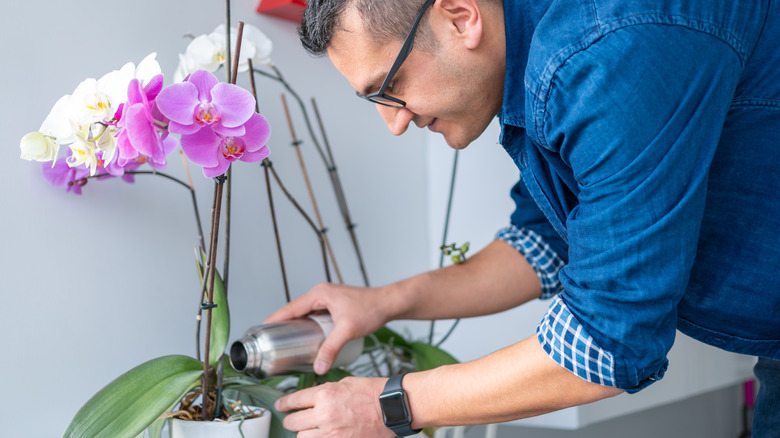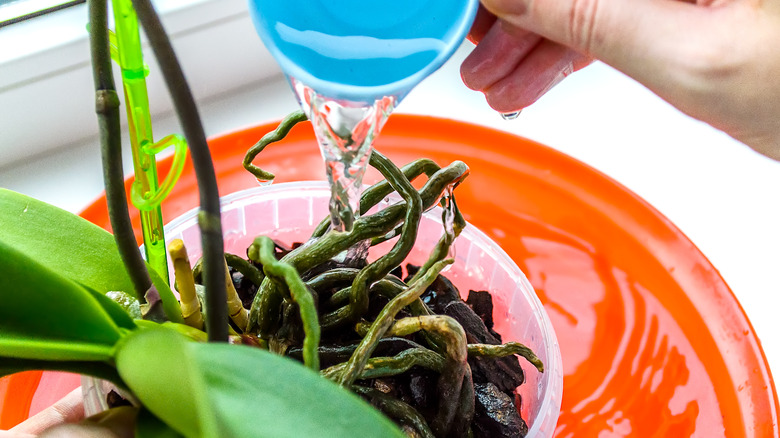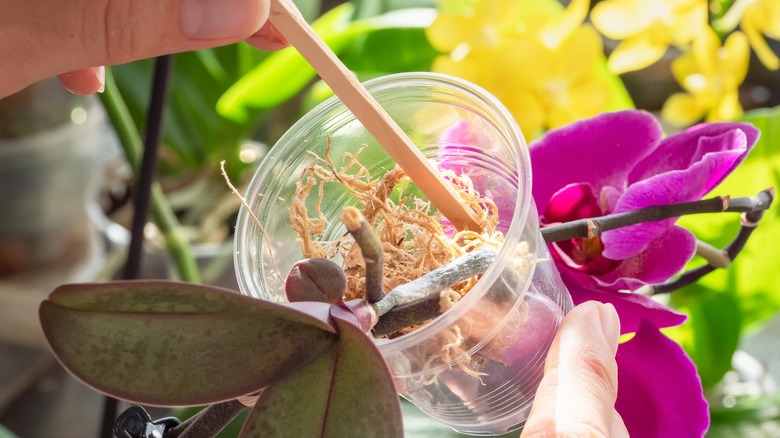The Best Method For Watering Orchids
With their beauty, elegance, color diversity, it's no wonder people around the world are obsessed with orchids. At their core, the flamboyant flowers are similar to child prodigies — they require special nurturing in order to reach their maximum potential. In the case of orchids, their unique needs involve hydration. Unfortunately, there's no one-size-fits-all watering method for orchids; rather, selecting the best hydration technique depends on what the plant is potted in: bark or moss.
Learning how to successfully care for indoor orchids isn't as complex as you may think. In fact, orchids won't hesitate to tell you when they are in trouble. In most instances, the problem involves underwatering or overwatering. Symptoms of the former include yellow, wilted leaves and colorless, shriveled roots, while signs of the latter consist of brown-spotted leaves and mushy, foul-smelling roots. Even if you have extremely limited knowledge regarding orchid care, you may have heard about its often-controversial relationship with ice cubes. Some orchid breeders believe adding ice cubes to the plant's container is the perfect way to measure hydration, while others maintain frozen water can damage its roots. Though, according to the American Society for Horticultural Science, there's no harm in watering orchids with ice cubes. Nevertheless, the following watering methods may prove even more effective in keeping your orchids alive and thriving.
How to water orchids potted in bark
If you purchased an orchid plant from a supermarket or big box store, chances are it came potted in bark. Due to water-repellent resin and wax coating on bark, the medium requires extra hydration to become fully saturated; consequently, a simple showering from a watering can will not suffice. To properly hydrate orchids in bark, place the entire pot into a container deep enough to meet or exceed the bark line. Next, pour copious amounts of fresh water over the bark. Don't stop until the container holding the orchid pot is filled to just below the top of the pot. It's best to allow the bark to absorb the water for about 15 minutes. Then, remove the pot from the container, making sure it has completely drained out prior to returning the orchid to its display spot.
If you are worried that watering your orchid from above will promote bacterial growth and leaf spotting due to excess moisture accumulating on the leaves, consider watering from below. Simply fill your sink or a bowl with lukewarm water and set it inside. Allow it to soak for the same time as previously stated, then drain the excess water. Depending on the type of orchid and the climate you live in, you will typically need to repeat the watering process every four to 10 days. If your home is very warm or lacks humidity, plan on watering your orchid more frequently.
How to water orchids potted in moss
Sphagnum moss is another popular potting medium for orchids. However, while moss retains water easier and longer than bark, it also features some challenges. Sphagnum moss' surface dryness can trick orchid growers into thinking it's time to water when it's not. The moss may appear and feel parched on the top, but beneath the surface it is still moist. It's best to test the level of dampness by sticking your finger, a popsicle stick, or wooden chopstick into the moss to measure moistness. This is especially important if your orchid is growing in a glazed ceramic, glass, or plastic pot, as those materials hold onto moisture longer.
To avoid water accumulating in the orchid's crown and potentially causing crown rot, do not use a watering can or spray bottle to hydrate the plant from above. Instead, submerge the orchid in a sink filled with water; however, keep the soak time to no more than 10 minutes. Given its spongy texture, it is easy to overwater an orchid potted in moss. To avoid doing so, take a good look at the plant's roots. If you notice they are dark brown or squishy, take a break from watering. Another cue that your orchid is not thirsty is by the weight of the pot. If it is heavy, there is no need to water. As the moss dries out, the container will feel much lighter, indicating your orchid needs a drink.


